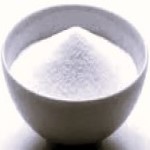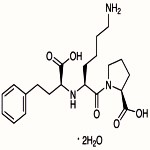CAS Number 83915-83-7 dihydrate or 76547-98-3 anhydrous, Lisinopril Dihydrate Anhydrous USP IP BP Ph Eur EP Grade Manufacturers Exporters







CAS Number 83915-83-7 dihydrate or 76547-98-3 anhydrous, Lisinopril USP IP BP Ph Eur EP Manufacturer Exporter
For Properties Specifications of Lisinopril Click Properties, Specifications of Lisinopril Manufacturer.
For Uses of aaa Click Uses of Lisinopril Manufacturer.
For For SDS MSDS Sheet of Lisinopril Click SDS Safety Data Sheet MSDS Sheet of Lisinopril Manufacturer.
The Properties and Specifications of Lisinopril Dihydrate Anhydrous:
Lisinopril Dihydrate BP Ph Eur Grade:
C21H31N3O5-2H2O --- 441.5 CAS 83915-83-7
Action and use: Angiotensin converting enzyme inhibitor.
DEFINITION
(2S)-1-[(2S)-6-Amino-2-[[(1S)-1-carboxy-3-phenylpropyl]amino]hexanoyl]pyrrolidine-2-carboxylic acid dihydrate.
Content: 98.5 per cent to 101.5 per cent (anhydrous substance).
CHARACTERS
Appearance: White or almost white, crystalline powder.
Solubility: Soluble in water, practically insoluble in anhydrous ethanol and in heptane.
IDENTIFICATION
A. Specific optical rotation: -47 to -43 (anhydrous substance).
Dissolve 0.5 g in zinc acetate solution and dilute to 50.0 mL with the same solvent.
B. Infrared absorption spectrophotometry.
TESTS
Related substances: To pass the test by Liquid chromatography.
Water: 8.0 per cent to 9.5 per cent, determined on 0.200 g.
Sulfated ash: Maximum 0.1 per cent, determined on 1.0 g.
Lisinopril USP Grade Specifications:
C21H31N3O5- 2H2O --- 441.52
l-Proline, 1-[ N 2 -(1-carboxy-3-phenylpropyl)-l-lysyl]-, dihydrate, (S)-;
1-[ N 2 -[(S)-1-Carboxy-3-phenylpropyl]-l-lysyl]-l-proline dihydrate
CAS: 83915-83-7
UNII: E7199S1YWR
UNII: 7Q3P4BS2FD
DEFINITION
Lisinopril contains NLT 98.0% and NMT 102.0% of lisinopril (C21H31N3O5), calculated on the anhydrous basis.
IDENTIFICATION
A. Infrared Absorption
B. The retention time of the major peak of the Sample solution corresponds to that of the Standard solution, as obtained in the Assay.
Residue on Ignition: NMT 0.1%
Organic Impurities: To pass the test by chromatography.
Optical Rotation, Specific Rotation: To pass the test. --- Acceptance criteria: −115.3° to −122.5° (λ = 405 nm)
Water Determination: 8.0%–9.5%
Packaging and Storage: Preserve in well-closed containers.
We also supply Lisinopril Dihydrate Anhydrous EP IP Grade.
The Uses of Lisinopril Dihydrate Anhydrous:
Lisinopril is a belonging to the drug class of angiotensin-converting enzyme (ACE) inhibitors and is used to treat hypertension, heart failure, and heart attacks.
The MSDS-SDS Hazard Statement of Lisinopril Dihydrate Anhydrous:
Lisinopril Dihydrate Anhydrous SDS, Safety Data Sheet
MSDS Sheet, Material safety Data Sheet 16-Nov-24
1. Product Identification
Product Name & Other Names: Lisinopril Dihydrate Anhydrous.
CAS No.: 83915-83-7 dihydrate or 76547-98-3 anhydrous
EINECS: EC Number: 627-033-9
Relevant uses and uses advised against (if any): Industrial Manufacturing.
Suppliers: As per letterhead.
2. Hazards Identification
GHS, Globally Harmonized System Classification in accordance with 29 CFR 1910
Classification according to Regulation (EC) No 1272/2008
Reproductive toxicity Category 1B, (H360)
Labeling according to Regulation (EC) No 1272/2008
GHS Label Elements  Health Hazard |
Signal word: Danger.
Hazard statements:
H360 May damage fertility. May damage the unborn child.
Precautionary statements:
P210: Keep away from heat/sparks/open flames/hot surfaces – No smoking.
P261 Avoid breathing dust/ fume/ gas/ mist/ vapors/ spray.
P270: Do not eat, drink, or smoke when using this product.
P280 Wear protective gloves/ eye protection/ face protection.
P305+P351+ P338: IF IN EYES: Rinse cautiously with water for several minutes. Remove contact lenses, if present and easy to do. Continue rinsing.
3. Composition/Information on Ingredients
Product Name & Other Names: Lisinopril Dihydrate Anhydrous.
CAS No.: 83915-83-7 dihydrate or 76547-98-3 anhydrous
EINECS: EC Number: 627-033-9
4. First Aid Measures
Always seek medical attention after first aid measures are provided.
Inhalation: Remove to fresh air. If not breathing, give artificial respiration. If breathing is difficult, give oxygen. Get medical attention.
Ingestion: Never give anything by mouth to an unconscious person. Get medical attention.
Skin Contact: Wipe off excess material from skin then immediately flush skin with plenty of water for at least 15 minutes. Remove contaminated clothing and shoes. Get medical attention. Wash clothing before reuse. Thoroughly clean shoes before reuse.
Eye Contact: Immediately flush eyes with plenty of water for at least 15 minutes, lifting lower and upper eyelids occasionally. Get medical attention.
5. Fire Fighting Measures
Flammability of the Product: It is an organic material. Forms explosive mixtures with air on intense heating.
Products of Combustion: It emits Carbon oxides, Nitrogen oxides and fumes when heated.
Fire Extinguishing Media: Water spray, alcohol-resistant foam, dry chemical, or carbon dioxide. Avoid solid water jet as it can scatter the fire.
Special Information: In the event of a fire, wear full protective clothing and NIOSH-approved self-contained breathing apparatus with full face piece operated in the pressure demand or other positive pressure mode.
6. Accidental Release Measures
Personal precautions, protective equipment, and emergency procedures: Avoid breathing dust/fumes/gas/mist/vapors/spray. Use individual protective equipment (waterproof boots, suitable protective clothing, safety glasses, etc.).
Environmental precautions: Do not let the product enter drains, soil, or water sources.
Methods and materials used for containment cleanup procedures and Storage:
Small Spill: Eliminate all sources of ignition. Avoid dust-mist formation. Avoid breathing dust. Ensure adequate ventilation. Use appropriate tools to put the spilled material in a convenient waste disposal container.
Large Spill: Eliminate all sources of ignition. Do not inhale dust, vapors, mist, or gas. Avoid dust formation. Contain spilled material. Cover with an inert, non-combustible absorbent material, (e.g., sand, earth, diatomaceous earth, vermiculite). Use a shovel to put the material into a convenient waste disposal container.
7. Handling and Storage
Precautions for safe handling: Apply according to good manufacturing and industrial hygiene practices. Ensure proper ventilation. In case of insufficient ventilation, wear suitable respiratory equipment. Wash thoroughly after handling. Do not drink, eat, or smoke while handling. Avoid contact with skin, eyes, and clothing. Avoid breathing dust/fumes/gas/mist/vapors/spray. Keep container tightly closed. Avoid ingestion and inhalation. Use individual protective equipment (waterproof boots, suitable protective clothing, safety glasses, etc.).
Conditions for safe storage, including any incompatibilities: Store in cool, dry, and ventilated area away from heat sources and protected from sunlight in tightly closed original container. Store protected from heat, sparks and ignition sources and incompatible materials.Avoid inhalation of dust/mist/vapor. Do not store with incompatible materials like strong oxidizing agents. Storage: Refrigerate. 2C to 8C.Heat sensitive.
8. Exposure Controls/Personal Protection
Airborne Exposure Limits: This product does not contain any hazardous materials with occupational exposure limits established by the region-specific regulatory bodies.
Ventilation System: A system of local and/or general exhaust is recommended to keep employee exposures as low as possible.
Personal Respirators (NIOSH Approved): For conditions of use where exposure to dust or mist is apparent and engineering controls are not feasible, a particulate respirator may be worn.
Skin Protection: Wear protective gloves and clean body-covering clothing.
Eye Protection: Use chemical safety goggles and/or full-face shield where dusting or splashing of solutions is possible. Maintain eye wash fountain and quick-drench facilities in work area.
Other Control Measures: Maintain good housekeeping in work area. Handle in accordance with good industrial hygiene and safety practice. Wash hands after handling.
9. Physical and Chemical Properties
Appearance: White to almost white powder or crystals. Heat sensitive.
Odor: No data found.
Odor threshold: No data found.
pH: No data found.
Relative density: No data found.
Boiling Point: No data found.
Melting Point: 148C literature.
Flash Point: No data found.
Auto-ignition temperature: No data found.
Decomposition temperature: No data found.
Upper/lower flammability or explosive limits: No data found.
Vapor pressure: No data found.
Vapor density: No data found.
Evaporation rate: No data found.
Flammability (solid, gas): No data found.
Partition coefficient: n-octanol/water: No data found.
Solubility: No data found.
Viscosity: No data found.
10. Stability and Reactivity
Stability: Stable under ordinary conditions of use and storage. Hygroscopic, Air sensitive, Light sensitive. Forms explosive mixtures with air on intense heating.
Hazardous Decomposition Products: It emits Carbon oxides, Nitrogen oxides and fumes.
Hazardous Polymerization: Will not occur.
Incompatibilities: Strong oxidizing agents, Heat.
Conditions to Avoid: Heat, Incompatibles.
11. Toxicological Information
Toxicity to Animals:
Oral-rat TDLo: 3600 mg/kg.
Carcinogenic Effects: Not a reported carcinogen.
Mutagenic Effects: No data found.
Teratogenic Effects: No data found.
Developmental Toxicity: Damage to fetus possible.
12. Ecological Information
Environmental Toxicity: No data found.
Results of PBT and vPvB assessment: This substance/mixture contains no components considered to be either persistent, bioaccumulative and toxic (PBT), or very persistent and very bioaccumulative (vPvB) at levels of 0.1% or higher.
13. Disposal Considerations
Whatever cannot be saved for recovery or recycling should be managed in an appropriate and approved waste disposal facility. Follow all the pollution control laws.
14. Transport Information
DOT USA, TDG Canada & ADR/RID Europe: Not dangerous goods.
IMDG/IMO: Not dangerous goods.
IATA: Not dangerous goods.
15. Regulatory Information
USA:
SARA 311/312 Hazards: See section 2.
California Prop. 65 Components: Not listed.
16. Other Information
Disclaimer:
**************************
Our company provides this MSDS sheet in good faith but makes no representation as to its comprehensiveness or accuracy. This SDS sheet is intended only as a guide to the appropriate precautionary handling of the material by a properly trained person using this product. The above information has been compiled from various sources and has the possibility of discrepancy and being out-dated information. Individuals receiving the information must exercise their independent judgment and do further search in determining its appropriateness for a particular purpose. In no case shall our company be liable to loss or damages by the product user.
**************************
Anmol Chemicals & Pharmaceuticals Pvt. Ltd. is an off-shoot of Anmol Chemicals Taloja. It is located in MIDC Taloja and it is manufacturing pharmaceutical grades of API, Excepients, Food grade and Reagent grade chemicals. Anmol Chemicals & Pharmaceuticals Pvt. Ltd. is a several decades old group of companies, engaged in manufacturing, supplying, distributing, wholesale supplies for actual users, retail or small pack supplies for research and development chemicals, fine and speciality chemicals, pharmaceutical excipients, mineral fortifiers in chemically pure, Analytical reagent grade, IP BP USP Ph Eur EP JP and other pharmaceutical grade monograph including FCC Food grade chemicals and Nutraceuticals, Mineral Fortifiers at best prices.

Lisinopril Dihydrate Structure
CAS Number 83915-83-7 dihydrate or 76547-98-3 anhydrous, Lisinopril Manufacturer Exporter
ANMOL CHEMICALS & PHARMACEUTICALS Pvt. Ltd.
India, USA, Europe, UAE
TELEPHONE: +912223770100
Navi Mumbai, INDIA
e-mail: info(At the rate i.e. @)anmol.org
Copyright. 18-nov-24
We manufacture:
Chlorhexidine Hydrochloride or Chlorhexidine Dihydrochloride or Chlorhexidine

